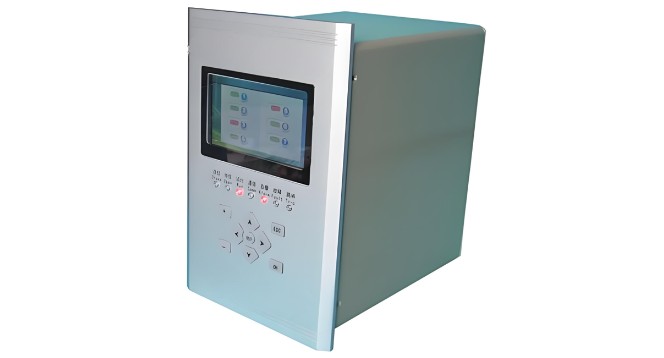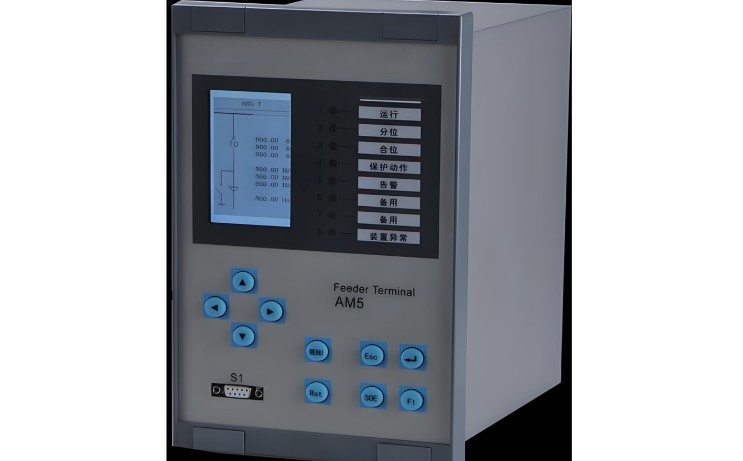1. Pagpili ug Pwersa sa mga Microcomputer Integrated Protection Devices
1.1 Pagpili sa mga Microcomputer Integrated Protection Devices
Arangkada ang pagpili sa disenyo aron siguraduhon nga ang microcomputer integrated protection device mahimong maayo ug eksakto nga makapahimulos sa iyang relay protection tasks, ang pagpili kini kinahanglan komprehensibong konsiderar ang reliability, response time, maintenance ug commissioning, ug adunay daghan pa ka lain nga mga function.
Ang signal input sa mga microcomputer integrated protection devices sama sa tradisyonal nga relay protection: ang voltage ug current signals gikuha gikan sa potential transformers (PTs) ug current transformers (CTs), gitransform niini ngadto sa standard signals nga gikinahanglan sa protection device, gisulbad aron maputli ang low- ug high-order harmonics ug uban pang disturbance, pagkahuman gitransform niini gikan sa analog to digital signals pinaagi sa A/D converter.
Ang CPU nagbuhat og computations sa digital input, nagsalig sa preset values, midecide, ug pagkahuman magdecide kung mogamit og alarm o trip. Aron mapasabot ang reliability requirements, ang measurement ug protection input signals giproseso ug gipagawas pinaagi sa independent processing units sulod sa device. Kini nagpadayon sa measurement accuracy samantalang naghatag usab og sapat nga allowance sa severe faults. Ang general engineering reliability satisfied kung ang device wala mag-experience og A/D overflow o saturation kon ang fault current nakahuman 20 times sa normal value.

1.2 Pagpili sa Response Time
Ang software workflow sa protection device kasagaran sama sa figure sa ubos:
Makita sa diagram nga ang response time sa protection device matugot sa software nga gigamit ug sa method sa electrical quantity calculation, kini kasagaran dili malamdon sa users.
Sa panahon sa pagdisenyo ug pagpili, mahimo lang naton judgahan ang quality sa protection device batasan sa tulo ka indicators: calculation accuracy, response time, ug computational load. Kini tulo ka factors mutually conflicting: ang poor calculation accuracy ug small computational load lead sa mas rapido nga response times, samtang ang higher accuracy ug larger computational load result sa mas slow response. Kasagaran, para sa end-users sa power grid, ang pag-set sa computational load sa greater than 3 times, calculation accuracy higher than 0.2%, ug maximum response time less than 30ms sufficient sa typical engineering requirements sa response time.
1.3 Pagpili sa uban pang mga Function
Ang integrated protection devices adunay daghan ka integrated circuits, kining gikinahanglan og high-level technical expertise sa maintenance. Sa panahon sa pagpili, prioritizar ang mga device nga modular ug standardized hardware, kini naghatag og kalihukan nga mahimong resolve ang hardware faults pinaagi sa simple replacement of modules, kini nag-improve sa work efficiency. Bisan unsa, ang protection device usab adunay built-in EPROM module, kini nag-enable sa tanang setting values ma-store digitally. Ang field personnel mahimong readily recall kini nga settings alang sa equipment commissioning wala na mag-reprogramming.
Aron mapabilin sa overall project automation monitoring system, ang protection device adunay communication capabilities, kini nag-enable sa easy network formation pinaagi sa data buses ug naghatag sa post-trip information ma-transmit sa upper-level automation monitoring system.
2. Relasyon sa Integrated Protection Devices ug Plant-wide Automation Control Systems
Batasan sa configuration ug communication requirements sa plant automation control system, ang automation system sa microcomputer integrated protection devices kasagaran gi-divide sa tulo ka layers: ang switchgear layer, substation layer, ug central control room.
2.1 Switchgear Layer
Ang switchgear layer gisusumala sa daghan ka types sa microcomputer integrated protection devices, directly installed sa switchgear. Ang bawat device directly handles ang measurement, protection signals, ug control functions para sa ilang respective cabinet. Ang specific functions as follows:
(1) Incoming Line Cabinet
Protection Functions: Instantaneous overcurrent, time-delayed overcurrent.
Measurement Functions: Three-phase current, three-phase voltage, active/reactive power, active/reactive energy.
Monitoring Functions: Circuit breaker open/closed position.
Control Functions: Manual open/close (on cabinet), remote open/close.
Alarm Functions: Trip due to accident, warning signals, open/close status, device fault, fault recording, etc.
(2) Transformer Cabinet
Protection Functions: Instantaneous overcurrent, time-delayed overcurrent, inverse-time overload, single-phase ground fault, heavy gas trip.
Measurement, Monitoring, and Control Functions: Same as incoming line cabinet.
Alarm Functions: Trip due to accident, light gas, temperature alarm, warning signals, open/close status, device fault, fault recording, etc.
(3) Busbar Cabinet
Protection, Monitoring, and Control Functions: Same as incoming line cabinet.
Alarm Functions: Trip due to accident, device fault, fault recording, etc.
(4) Motor Cabinet
Protection Functions: Instantaneous overcurrent, time-delayed overcurrent, overload, single-phase ground, undervoltage, overheating.
Measurement Functions: Three-phase current, three-phase voltage, active/reactive power, active/reactive energy.
Monitoring Functions: Circuit breaker open/closed position.
Control Functions: Manual open/close (on cabinet), remote open/close.
Alarm Functions: Trip due to accident, warning signals, open/close status, device fault, fault recording, etc.
Pagkahuman sa data acquisition sa ilang respective switchgears, ang protection devices imo maoy mag-transmit sa data pinaagi sa bus sa monitoring computer sa substation layer. Kini nga sistema gi-greatly reduce ang control cables, shorten ang on-site commissioning time, ug improve ang work efficiency.
2.2 Substation Layer
Daghan ka signals gikan sa substation kinahanglan i-transmit sa central control room pinaagi sa plant's industrial Ethernet, ug ang control commands gikan sa central control room kinahanglan i-receive ug i-send sa protection devices. Ang substation layer kasagaran gisusumala sa industrial control computers, printers, ug monitors. Ang iyang main functions include ang configuring ug managing sa switchgear protection devices, monitoring sa system operation, establishing ug managing sa substation database, ug communicating sa central control room.
Tungod sa confidentiality sa manufacturers bahin sa software ug electrical calculation methods sa ilang protection devices, ang substation layer usab ang nag-handle sa communication protocol conversion aron mapabilin ang signal transmission ug reception sa pagitan sa central control room ug protection devices.
2.3 Communication Network
Ang communication sa pagitan sa switchgear ug substation mahimo gamiton ang MODbus bus network, supporting up to 64 slave stations. Gi-optical isolation ang communication network ug devices aron maprevent ang external interference. Ang communication sa pagitan sa substation ug central control room gamiton ang industrial Ethernet sa fiber optic media, ang communication rate greater than 1 Mbps.
2.4 Software
Ang system software mahimo gamiton ang mainstream platforms sa international standard architectures, sama sa Windows NT. Ang software modules dapat include: master control software, graphics software, database management software, report generation software, ug communication software.
Sa panahon sa pagpili sa software, ang master control software dapat adunay high degree of modularity. Ang high modularity naghatag sa field personnel ang kalihukan nga ma-call up ang software batasan sa site conditions wala na mag-additional programming, significantly reducing ang operational ug maintenance workload sa dispatchers ug maintenance staff ug improving ang work efficiency.

3. Uban pang Considerations
Bisan unsa, ang sumala nga issues kinahanglan noted sa panahon sa hardware selection sa microcomputer integrated protection devices:
Gamiton ang sealed, reinforced enclosure nga resistant sa strong vibration ug interference, compact installation size, suitable sa harsh environments ug panel mounting.
Gamiton ang industrial-grade dual-CPU structure, sama sa bawat device adunay main CPU ug communication CPU. Ang duha ka CPUs nagtrabaho sa mutual inspection mode aron mapataas ang response time ug accuracy, prevent maloperation o failure to operate, ug enhance stability ug reliability.
Full-range temperature automatic compensation allows the device to operate long-term in environments from -20°C to +60°C.
Separate processing of measurement and protection signals within the device, satisfying both accuracy requirements and the requirements for protection range and reliability.
Use a dedicated frequency sampling circuit to precisely track grid frequency, making electrical quantity calculations more accurate.
Use optical isolation for digital input/output, and shielded cables for internal cabinet wiring, effectively preventing external interference and improving the device's anti-interference capability.
Use a large-screen LCD display and soft keypad for clearer numerical display and easier operation.
After commissioning and operation, various protection setting values are stored digitally in EPROM, allowing for immediate recall after commissioning or circuit fault repair.
Equipped with a fully functional circuit breaker operating circuit, suitable for controlling various types of circuit breakers, facilitating substation retrofitting.
Has comprehensive accident analysis capabilities, including protection action event records, electrical quantity signal over-limit records, and fault recording.
4. Role of Microcomputer Integrated Protection Devices in High-Voltage Switchgear
Microcomputer protection devices safeguard against abnormal conditions in circuits. Their roles in high-voltage switchgear include:
Microcomputer protection devices possess powerful data processing, logical computation, and information storage capabilities, featuring advanced internal architectures. They offer complete protection functions equivalent to conventional relay protection. By receiving signals from measurement components such as current and voltage transformers, the device can monitor, control, and protect the circuit state—such as short-circuit protection, overload protection, and single-phase ground fault protection.
Without protection devices, high-voltage switchgear uses relays to achieve these protective functions. Modern microcomputer protection provides enhanced functionality, such as easy remote control, communication with upper-level systems to transmit current, voltage, power, and energy data, and convenient adjustment of protection settings.
























